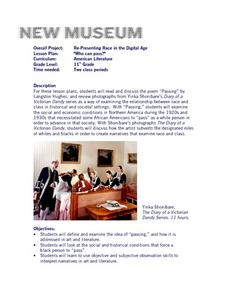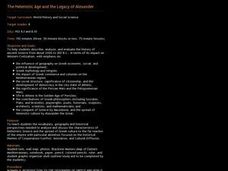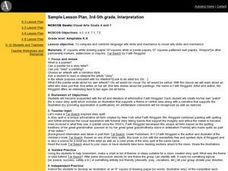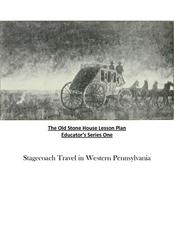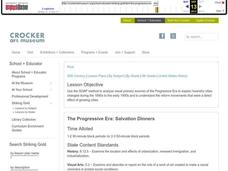Curated OER
The Puzzle of the Ice Age Americans
Students describe alternative theories for how the first humans cane to America. In this human origin instructional activity students study the origins of the first Americans.
Curated OER
Re-Presenting Race in the Digital Age: "Who Can Pass"
Eleventh graders examine the relationship between race and class in historical and societal settings. They read and discuss the poem, "Passing," by Langston Hughes, analyze photographs by Yinka Shonibare, answer discussion questions,...
Curated OER
Anti-Semitism Throughout the Ages
Learners investigate the implication of anti-Semitism. In this prejudice lesson, students compare anti-Semitism to bullying as they research the propaganda techniques employed during the Holocaust and throughout history.
Curated OER
Basic Words- Grades 2-4
In this basic words learning exercise, students click on the pictures based on the words they hear, and choose the correct description to pictures. Students complete 2 activities.
Curated OER
Report Writing in Primary Grades
Students listen and restate facts from a text. They gather and organize information as a class. They create a report and present it to their classmates.
Curated OER
Age Brings Wisdom -- Learning to Respect Elders
Students read a story about a young Japanese boy and his mother who decide to not banish the community's elders to the hills. They create origami helmets. They work together to make posters appreciating senior citizens.
Curated OER
Fruits and Vegetables: Primary Grades
Students complete a variety of activities in their study of fruits and vegetables. They role play a grocer in the produce department; they go on a scavenger hunt; they sample different foods made with fruits and vegetables.
Curated OER
The Helenistic Age and the Legacy of Alexander
Eighth graders describe, analyze and evaluate the history of ancient Greece from 2000 to 300 B.C. They explore the influence of geography on Greek economical, social, and political development.
Curated OER
1st Grade - Act. 03: T-Shirt Glyph
First graders create glyphs (symbols or icons) which represents them, and read the glyphs of others using a legend to explain the data on the glyphs.
Curated OER
Sixth Grade Social Studies Quiz
In this social studies worksheet, 6th graders complete multiple choice questions about economics, climate, maps, and more. Students complete 15 questions.
Curated OER
Sample Lesson Plan, 3rd-5th grade, Interpretation
Students become acquainted with the art and literature of artist/author Faith Ringgold.
Curated OER
A Golden Age: Three West African Empires
Seventh graders research the kingdoms and rulers of Ghana, Mali and Songhay. In groups, they explore the trade routes and the spread of Islam. Using the internet, textbook and other sources, 7th graders collect information and write a...
Curated OER
Time for All Ages
Fourth graders discover time keeping by analyzing technological advances in history. In this time lesson, 4th graders create and complete a KWL chart based on their research of a famous timekeeping invention, such as a sundial....
Curated OER
Space Age Technology Comes to Earth
Students explore jobs related to agriculture. In this technology/agriculture lesson, students recognize the importance of natural resources and agriculture on the use of Range Rambler software. Students complete an experiment and a...
Curated OER
Canada Recycles! Do You?: Grades 4-6
In this recycling education instructional activity, students read a table regarding Canadian recycling statistics and respond to 9 questions regarding the data.
Curated OER
Present Simple Exercise Review, 3rd Grade
In this nature worksheet, students watch a nature video, answer multiple choice questions, complete word searches on trees and nature, and more. Students complete 6 activities.
Alabama Department of Archives and History
Working in Birmingham's Iron Industry
What did railroads, iron, and industry contributed to Birmingham's successful growth? The instructional activity explains how the iron industry worked. It also describes how the location of Birmingham and its proximity to railroads....
Curated OER
Old Stone House Lesson Plan
From stagecoach to railroad tracks, your class will discover how advancements in travel in the United States during the nineteenth century played an integral role in the industrialization and development of American society. The main...
David Pleacher
Candy Math Fun
Few things can motivate children to learn like the promise of a sweet and tasty treat. Given a bag of M&M®s, Skittles®, or other colorful candy, students first predict the contents of the bag before counting the pieces, creating a...
EngageNY
Launching A Midsummer Night’s Dream: The Universal Appeal of Shakespeare, Part 2
As scholars prepare to read Shakespeare's A Midsummer Night's Dream, they first read the article "Shakespeare's Universal Appeal Examined" and analyze its central idea. Next, pupils complete Frayer Model worksheets to understand better...
EngageNY
Analyzing Text Structure: “Generation Z Stereotyped”
Breaking the stereotype. Readers use the Generation Z Stereotyped Structure anchor chart and find the central idea of the text. They then read Generation Z with partners and discuss the text using guiding questions. Finally, they answer...
EngageNY
Comparing Text to Multimedia: Understanding How the Brain Changes
Learners explore how the human brain changes over time, comparing an interactive web page about brain development to a text-only version. Additionally, pupils continue reading an article about teen decision making, analyzing the main...
EngageNY
Evaluating Sources, Continued: The ONLINE EDUCA Debate 2009 (Part 2 of 10)
Watching videos and playing online games can be educational, but too much screen time has its drawbacks. Pupils watch a video about the topic and write down the claim, reasons, and evidence in support of reduced screen time for children....
Curated OER
The Progressive Era
Eighth graders utilize the SOAP method to analyze a work of art and relate it to what they know about the Progressive Era and the reasons why cities changed and the ways in which cities changed during the end of the 19th century. They...



